Wow, that is a good idea, though I'm not sure I'm smart enough to code it!
In the meantime, while I think about how your idea might be implemented, here's an option that many might not know about, that I find useful for the very reason we've been discussing (that the first TDI points are the most valuable points for extrapolating to zero time).
Let's start with a normal obsidian glass analysis, this was acquired with Combined Conditions, so the major elements are acquired as a lower beam current (10 nA) than the traces (50 nA) as seen here:

Using *no* TDI correction we get these results for quantification:
Un 6 Obsidian trav1
(Magnification (analytical) = 20000), Beam Mode = Analog Spot
(Magnification (default) = 2524, Magnification (imaging) = 736)
Image Shift (X,Y): .00, .00
Number of Data Lines: 50 Number of 'Good' Data Lines: 18
First/Last Date-Time: 11/19/2013 05:52:20 PM to 11/20/2013 12:08:21 AM
WARNING- Using Exponential Off-Peak correction for p ka
WARNING- Using Exponential Off-Peak correction for zr la
Average Total Oxygen: 48.564 Average Total Weight%: 97.796
Average Calculated Oxygen: 48.564 Average Atomic Number: 11.176
Average Excess Oxygen: .000 Average Atomic Weight: 20.541
Oxygen Equiv. from Halogen: .008 Halogen Corrected Oxygen: 48.555
Average ZAF Iteration: 3.00 Average Quant Iterate: 4.00
Oxygen Calculated by Cation Stoichiometry and Included in the Matrix Correction
Oxygen Equivalent from Halogens (F/Cl/Br/I), Not Subtracted in the Matrix Correction
Combined Analytical Condition Arrays:
ELEM: Na Si K Al Mg Fe Ca Sr Mn S Cl Ti P Zr
TAKE: 40.0 40.0 40.0 40.0 40.0 40.0 40.0 40.0 40.0 40.0 40.0 40.0 40.0 40.0
KILO: 15.0 15.0 15.0 15.0 15.0 15.0 15.0 15.0 15.0 15.0 15.0 15.0 15.0 15.0
CURR: 10.0 10.0 10.0 10.0 10.0 10.0 10.0 10.0 10.0 50.0 50.0 50.0 50.0 50.0
SIZE: 10.0 10.0 10.0 10.0 10.0 10.0 10.0 10.0 10.0 10.0 10.0 10.0 10.0 10.0
Un 6 Obsidian trav1, Results in Elemental Weight Percents
ELEM: Na Si K Al Mg Fe Ca Sr Mn S Cl Ti P Zr O H
TYPE: ANAL ANAL ANAL ANAL ANAL ANAL ANAL ANAL ANAL ANAL ANAL ANAL ANAL ANAL CALC SPEC
BGDS: MAN MAN LIN MAN MAN MAN MAN LIN LIN LIN LIN LIN EXP EXP
TIME: 90.00 60.00 20.00 80.00 60.00 160.00 80.00 40.00 30.00 100.00 100.00 100.00 100.00 100.00
BEAM: 9.99 9.99 9.99 9.99 9.99 9.99 9.99 9.99 9.99 50.29 50.29 50.29 50.29 50.29
ELEM: Na Si K Al Mg Fe Ca Sr Mn S Cl Ti P Zr O H SUM
178 1.770 35.590 3.816 7.044 .024 .511 .356 .060 .071 .002 .044 .036 .001 -.010 48.570 .000 97.884
179 1.762 35.561 3.809 7.033 .016 .501 .351 .007 .048 .003 .046 .046 -.004 -.011 48.496 .000 97.663
180 1.775 35.653 3.788 7.074 .017 .443 .364 .016 .046 .003 .042 .028 -.004 .006 48.622 .000 97.872
181 1.815 35.576 3.802 6.993 .017 .471 .362 .032 .055 -.001 .039 .050 -.003 -.009 48.503 .000 97.703
182 1.809 35.728 3.724 7.057 .021 .496 .369 -.021 .053 -.001 .041 .027 .000 -.008 48.706 .000 98.001
183 1.829 35.621 3.802 7.019 .022 .465 .371 -.003 .058 -.001 .040 .037 -.003 -.006 48.573 .000 97.824
184 1.855 35.658 3.775 7.054 .019 .516 .358 -.006 .064 .002 .035 .038 -.003 .001 48.662 .000 98.028
185 1.861 35.641 3.807 6.993 .023 .493 .365 -.009 .040 .002 .036 .020 -.001 -.020 48.573 .000 97.825
186 1.826 35.627 3.804 7.037 .024 .466 .363 -.017 .039 .001 .033 .037 .000 .000 48.594 .000 97.836
187 1.831 35.592 3.831 6.959 .023 .462 .354 .040 .033 .000 .036 .042 -.005 -.010 48.487 .000 97.674
188 1.829 35.573 3.765 7.059 .016 .403 .351 .031 .040 .001 .034 .023 .000 -.002 48.514 .000 97.637
189 1.855 35.602 3.849 7.017 .019 .386 .355 .007 .029 .001 .033 .030 .003 -.006 48.534 .000 97.715
190 1.861 35.704 3.837 7.054 .016 .426 .343 .032 .042 .002 .033 .027 -.006 -.015 48.680 .000 98.037
191 1.832 35.588 3.759 7.006 .019 .439 .352 .001 .047 -.002 .034 .039 -.002 -.020 48.494 .000 97.586
192 1.842 35.558 3.805 7.003 .018 .460 .361 .037 .064 -.001 .034 .034 -.001 -.006 48.494 .000 97.703
193 1.876 35.672 3.773 6.995 .019 .476 .366 .032 .051 .000 .034 .031 .000 -.012 48.623 .000 97.937
194 1.789 35.682 3.836 7.001 .019 .465 .351 -.013 .055 -.001 .035 .020 -.002 -.008 48.596 .000 97.825
195 1.865 35.482 3.772 7.013 .016 .471 .352 .065 .040 .000 .035 .049 .004 -.018 48.427 .000 97.573
AVER: 1.827 35.617 3.797 7.023 .019 .464 .358 .016 .049 .001 .037 .034 -.001 -.009 48.564 .000 97.796
SDEV: .035 .060 .032 .030 .003 .035 .008 .026 .011 .002 .004 .009 .003 .007 .076 .000 .147
SERR: .008 .014 .008 .007 .001 .008 .002 .006 .003 .000 .001 .002 .001 .002 .018 .000
%RSD: 1.89 .17 .84 .43 14.75 7.53 2.11 161.28 23.09 265.87 10.91 26.42 -199.09 -82.48 .16 .00
STDS: 336 14 374 160 162 162 162 251 25 730 285 22 285 257 0 0
STKF: .0735 .4101 .1132 .0334 .0568 .0950 .1027 .4268 .7341 .5061 .0601 .5547 .1599 .4201 .0000 .0000
STCT: 71.42 566.01 224.55 62.55 81.21 18.31 161.20 292.31 2053.05 449.51 79.86 58.15 227.12 213.15 .00 .00
UNKF: .0100 .2943 .0329 .0559 .0001 .0039 .0032 .0001 .0004 .0000 .0003 .0003 .0000 -.0001 .0000 .0000
UNCT: 9.75 406.17 65.30 104.57 .19 .75 5.02 .09 1.12 .00 .39 .03 -.01 -.03 .00 .00
UNBG: .32 .22 .94 .89 .52 .23 1.01 .94 4.78 .16 .33 .05 .81 .88 .00 .00
ZCOR: 1.8208 1.2103 1.1537 1.2567 1.4293 1.1985 1.1194 1.2284 1.2180 1.2872 1.2540 1.1978 1.4649 1.4613 .0000 .0000
KRAW: .1365 .7176 .2908 1.6717 .0024 .0407 .0312 .0003 .0005 .0000 .0049 .0005 -.0001 -.0001 .0000 .0000
PKBG: 31.48 1852.73 70.81 118.92 1.37 4.30 5.97 1.11 1.24 1.03 2.20 1.65 .98 .97 .00 .00
INT%: ---- ---- ---- ---- ---- -.01 ---- -94.80 ---- ---- ---- ---- ---- ---- ---- ----
Obviously the totals are low, so we might suspect a TDI situation (even though we used a 10 um beam for all the points). If we examine the TDI data (I almost always just leave this acquisition option turned on because it uses very little overhead, and if you do run into a TDI situation you already have the intensity interval data to perform a TDI correction), you'll see a significant decrease in the Na intensities over time as seen here:
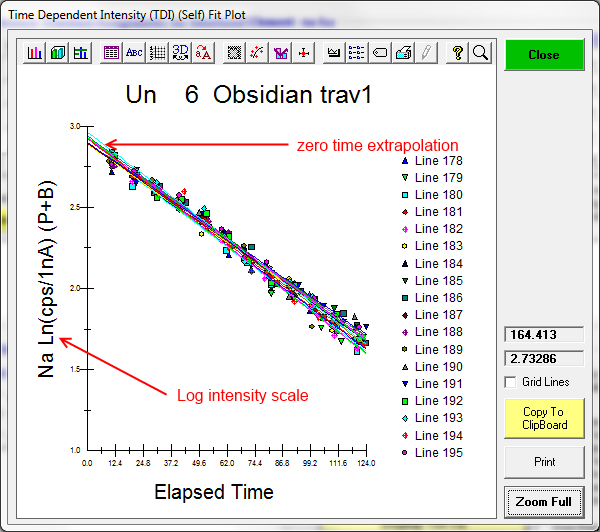
For Si ka the situation is less dire (and is barely statistically significant), but worth a correction:
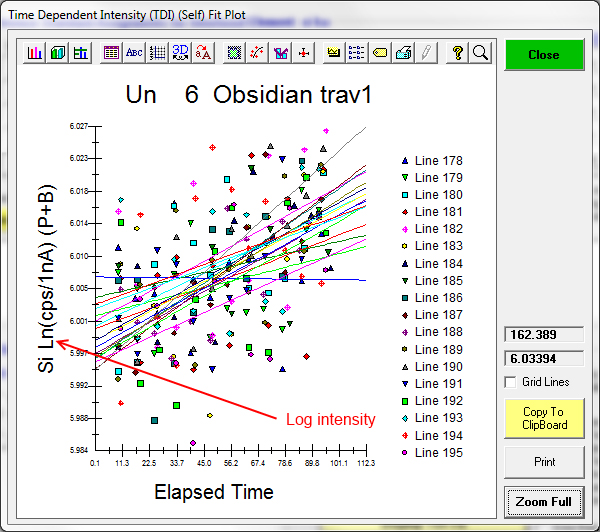
Al ka is somewhat more statistically significant as seen here:
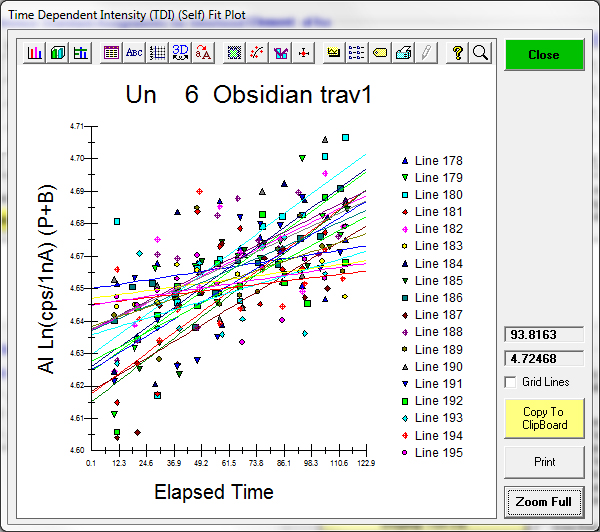
The results for these linear (exponential) extrapolations are seen here:
Un 6 Obsidian trav1, Results in Elemental Weight Percents
ELEM: Na Si K Al Mg Fe Ca Sr Mn S Cl Ti P Zr O H
TYPE: ANAL ANAL ANAL ANAL ANAL ANAL ANAL ANAL ANAL ANAL ANAL ANAL ANAL ANAL CALC SPEC
BGDS: MAN MAN LIN MAN MAN MAN MAN LIN LIN LIN LIN LIN EXP EXP
TIME: 90.00 60.00 20.00 80.00 60.00 160.00 80.00 40.00 30.00 100.00 100.00 100.00 100.00 100.00
BEAM: 9.99 9.99 9.99 9.99 9.99 9.99 9.99 9.99 9.99 50.29 50.29 50.29 50.29 50.29
ELEM: Na Si K Al Mg Fe Ca Sr Mn S Cl Ti P Zr O H SUM
178 3.458 35.730 3.773 7.123 .025 .509 .356 .061 .071 .002 .044 .036 .001 -.010 49.379 .000 100.556
179 3.582 35.538 3.941 6.956 .017 .467 .351 .008 .048 .003 .046 .045 -.004 -.011 49.052 .000 100.038
180 3.500 35.492 3.746 6.986 .019 .428 .364 .018 .046 .003 .042 .028 -.004 .006 48.949 .000 99.621
181 3.414 35.456 3.844 6.899 .018 .454 .362 .034 .055 -.001 .039 .050 -.003 -.009 48.843 .000 99.455
182 3.611 35.556 3.657 7.047 .022 .476 .369 -.018 .053 -.001 .041 .027 .000 -.008 49.110 .000 99.943
183 3.451 35.456 3.873 7.107 .023 .487 .371 .000 .058 -.001 .040 .037 -.003 -.006 49.050 .000 99.944
184 3.550 35.447 3.738 6.971 .020 .501 .358 -.003 .064 .002 .035 .038 -.003 .001 48.927 .000 99.646
185 3.516 35.604 3.797 6.893 .024 .414 .365 -.008 .040 .002 .036 .020 -.001 -.020 48.993 .000 99.676
186 3.600 35.384 3.810 7.045 .026 .428 .363 -.014 .039 .001 .033 .037 .000 .000 48.933 .000 99.685
187 3.442 35.291 3.888 6.912 .024 .454 .354 .044 .033 .000 .036 .042 -.005 -.010 48.673 .000 99.178
188 3.502 35.386 3.720 7.048 .017 .406 .351 .033 .040 .001 .034 .023 .000 -.002 48.865 .000 99.424
189 3.609 35.398 3.754 7.058 .020 .376 .355 .010 .029 .001 .033 .030 .003 -.006 48.927 .000 99.596
190 3.459 35.330 3.871 7.052 .018 .453 .343 .036 .042 .002 .033 .027 -.006 -.015 48.824 .000 99.469
191 3.454 35.410 3.676 6.966 .020 .477 .351 .004 .047 -.002 .034 .039 -.002 -.020 48.815 .000 99.269
192 3.526 35.369 3.813 6.985 .020 .488 .360 .040 .063 -.001 .034 .034 -.001 -.006 48.860 .000 99.586
193 3.650 35.608 3.663 7.046 .021 .452 .366 .034 .051 .000 .034 .031 .000 -.012 49.184 .000 100.128
194 3.528 35.638 3.694 7.110 .020 .512 .351 -.011 .055 -.001 .035 .020 -.002 -.008 49.234 .000 100.175
195 3.533 35.369 3.739 7.109 .017 .472 .352 .067 .040 .000 .035 .049 .004 -.018 48.959 .000 99.728
AVER: 3.521 35.470 3.778 7.017 .021 .459 .358 .018 .049 .001 .037 .034 -.001 -.009 48.977 .000 99.729
SDEV: .068 .119 .083 .074 .003 .037 .008 .026 .011 .002 .004 .009 .003 .007 .170 .000 .347
SERR: .016 .028 .020 .017 .001 .009 .002 .006 .003 .000 .001 .002 .001 .002 .040 .000
%RSD: 1.94 .34 2.19 1.06 14.11 8.09 2.12 140.65 23.09 265.87 10.91 26.43 -199.11 -82.49 .35 .00
STDS: 336 14 374 160 162 162 162 251 25 730 285 22 285 257 0 0
STKF: .0735 .4101 .1132 .0334 .0568 .0950 .1027 .4268 .7341 .5061 .0601 .5547 .1599 .4201 .0000 .0000
STCT: 70.51 567.11 225.51 62.06 81.21 18.46 161.20 292.31 2053.05 449.51 79.86 58.15 227.12 213.15 .00 .00
UNKF: .0195 .2914 .0328 .0552 .0001 .0038 .0032 .0001 .0004 .0000 .0003 .0003 .0000 -.0001 .0000 .0000
UNCT: 18.68 403.03 65.30 102.52 .20 .74 5.02 .10 1.12 .00 .39 .03 -.01 -.03 .00 .00
UNBG: .32 .22 .94 .88 .51 .23 1.01 .94 4.78 .16 .33 .05 .81 .88 .00 .00
ZCOR: 1.8086 1.2170 1.1526 1.2706 1.4508 1.1979 1.1182 1.2346 1.2173 1.2854 1.2525 1.1969 1.4626 1.4590 .0000 .0000
KRAW: .2649 .7107 .2896 1.6521 .0025 .0403 .0312 .0004 .0005 .0000 .0049 .0005 -.0001 -.0001 .0000 .0000
PKBG: 59.19 1852.27 70.83 117.93 1.40 4.30 5.98 1.12 1.24 1.03 2.20 1.65 .98 .97 .00 .00
INT%: ---- ---- ---- ---- ---- -.02 ---- -93.93 ---- ---- ---- ---- ---- ---- ---- ----
TDI%: 88.751 -.772 -.008 -1.945 ---- -.173 ---- ---- ---- ---- ---- ---- ---- ---- ---- ----
DEV%: 5.8 .7 2.8 1.2 ---- 8.4 ---- ---- ---- ---- ---- ---- ---- ---- ---- ----
TDIF: LINEAR LINEAR LINEAR LINEAR ---- LINEAR ---- ---- ---- ---- ---- ---- ---- ---- ---- ----
TDIT: 125.56 97.78 61.11 117.28 ---- 198.17 ---- ---- ---- ---- ---- ---- ---- ---- ---- ----
TDII: 18.5 403. 66.2 103. ---- .963 ---- ---- ---- ---- ---- ---- ---- ---- ---- ----
The totals look good, but are we done? Well if we look more closely at the Na TDI plot above, we see that there seems to be a slight curvature in the linear (exponential) fit, so maybe we should utilize the quadratic fit in log space or "hyper-exponential" fit as seen here:
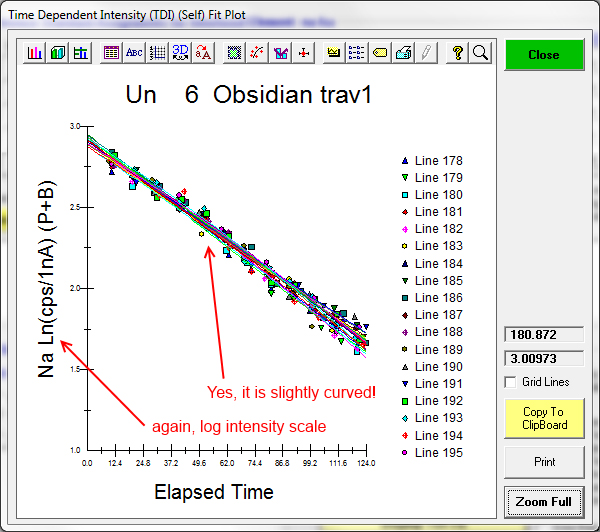
How does this tiny change affect our results? Not that much, but a little. Note the difference in the average deviation in the linear and quadratic fits for Na. The linear (conventional exponential fit) has a DEV% of 5.8, while the "hyper-exponential" (quadratic exponential fit) has a DEV% of 3.4, so the hyper-exponential is definitetely a better fit to the data as seen here:
Un 6 Obsidian trav1, Results in Elemental Weight Percents
ELEM: Na Si K Al Mg Fe Ca Sr Mn S Cl Ti P Zr O H
TYPE: ANAL ANAL ANAL ANAL ANAL ANAL ANAL ANAL ANAL ANAL ANAL ANAL ANAL ANAL CALC SPEC
BGDS: MAN MAN LIN MAN MAN MAN MAN LIN LIN LIN LIN LIN EXP EXP
TIME: 90.00 60.00 20.00 80.00 60.00 160.00 80.00 40.00 30.00 100.00 100.00 100.00 100.00 100.00
BEAM: 9.99 9.99 9.99 9.99 9.99 9.99 9.99 9.99 9.99 50.29 50.29 50.29 50.29 50.29
ELEM: Na Si K Al Mg Fe Ca Sr Mn S Cl Ti P Zr O H SUM
178 3.348 35.718 3.773 7.118 .025 .509 .356 .061 .071 .002 .044 .036 .001 -.010 49.322 .000 100.373
179 3.491 35.527 3.941 6.952 .017 .467 .351 .008 .048 .003 .046 .045 -.004 -.011 49.004 .000 99.885
180 3.286 35.467 3.747 6.976 .018 .428 .364 .018 .046 .003 .042 .028 -.004 .006 48.838 .000 99.264
181 3.284 35.442 3.844 6.893 .018 .454 .362 .034 .055 -.001 .039 .050 -.003 -.009 48.776 .000 99.238
182 3.335 35.524 3.658 7.035 .022 .476 .369 -.018 .053 -.001 .041 .027 .000 -.008 48.967 .000 99.481
183 3.360 35.446 3.873 7.103 .023 .487 .371 .000 .058 -.001 .040 .037 -.003 -.006 49.003 .000 99.790
184 3.379 35.427 3.739 6.964 .020 .501 .358 -.003 .064 .002 .035 .038 -.003 .001 48.839 .000 99.361
185 3.540 35.606 3.797 6.895 .024 .414 .365 -.008 .040 .002 .036 .020 -.001 -.020 49.006 .000 99.717
186 3.517 35.375 3.810 7.041 .026 .428 .363 -.014 .039 .001 .033 .037 .000 .000 48.890 .000 99.545
187 3.432 35.290 3.888 6.912 .024 .454 .354 .044 .033 .000 .036 .042 -.005 -.010 48.668 .000 99.161
188 3.320 35.365 3.720 7.040 .017 .406 .351 .033 .040 .001 .034 .023 .000 -.002 48.771 .000 99.118
189 3.309 35.364 3.754 7.044 .020 .376 .355 .010 .029 .001 .033 .030 .003 -.006 48.772 .000 99.094
190 3.479 35.332 3.871 7.053 .018 .453 .343 .036 .042 .002 .033 .027 -.006 -.015 48.834 .000 99.501
191 3.412 35.405 3.676 6.964 .020 .477 .351 .004 .047 -.002 .034 .039 -.002 -.020 48.793 .000 99.198
192 3.431 35.358 3.813 6.981 .019 .488 .360 .040 .063 -.001 .034 .034 -.001 -.006 48.811 .000 99.427
193 3.423 35.582 3.663 7.036 .020 .452 .366 .034 .051 .000 .034 .031 .000 -.012 49.066 .000 99.747
194 3.390 35.623 3.695 7.104 .020 .512 .351 -.011 .055 -.001 .035 .020 -.002 -.008 49.163 .000 99.944
195 3.324 35.346 3.740 7.099 .017 .472 .352 .067 .040 .000 .035 .049 .004 -.018 48.851 .000 99.379
AVER: 3.392 35.455 3.778 7.012 .020 .459 .358 .019 .049 .001 .037 .034 -.001 -.009 48.910 .000 99.512
SDEV: .079 .118 .083 .073 .003 .037 .008 .026 .011 .002 .004 .009 .003 .007 .162 .000 .341
SERR: .019 .028 .019 .017 .001 .009 .002 .006 .003 .000 .001 .002 .001 .002 .038 .000
%RSD: 2.32 .33 2.19 1.03 14.25 8.09 2.12 140.57 23.09 265.88 10.91 26.43 -199.12 -82.46 .33 .00
STDS: 336 14 374 160 162 162 162 251 25 730 285 22 285 257 0 0
STKF: .0735 .4101 .1132 .0334 .0568 .0950 .1027 .4268 .7341 .5061 .0601 .5547 .1599 .4201 .0000 .0000
STCT: 70.51 567.11 225.51 62.06 81.21 18.46 161.20 292.31 2053.05 449.51 79.86 58.15 227.12 213.15 .00 .00
UNKF: .0187 .2914 .0328 .0552 .0001 .0038 .0032 .0001 .0004 .0000 .0003 .0003 .0000 -.0001 .0000 .0000
UNCT: 17.98 403.03 65.30 102.52 .20 .74 5.02 .10 1.12 .00 .39 .03 -.01 -.03 .00 .00
UNBG: .32 .22 .94 .88 .51 .23 1.01 .94 4.78 .16 .33 .05 .81 .88 .00 .00
ZCOR: 1.8095 1.2165 1.1527 1.2696 1.4493 1.1979 1.1183 1.2342 1.2174 1.2855 1.2526 1.1969 1.4627 1.4597 .0000 .0000
KRAW: .2550 .7107 .2896 1.6521 .0025 .0403 .0312 .0004 .0005 .0000 .0049 .0005 -.0001 -.0001 .0000 .0000
PKBG: 57.04 1851.22 70.83 117.83 1.39 4.30 5.97 1.12 1.24 1.03 2.20 1.65 .98 .97 .00 .00
INT%: ---- ---- ---- ---- ---- -.02 ---- -93.93 ---- ---- ---- ---- ---- ---- ---- ----
TDI%: 81.846 -.772 -.008 -1.945 ---- -.173 ---- ---- ---- ---- ---- ---- ---- ---- ---- ----
DEV%: 3.4 .7 2.8 1.2 ---- 8.4 ---- ---- ---- ---- ---- ---- ---- ---- ---- ----
TDIF: QUADRA LINEAR LINEAR LINEAR ---- LINEAR ---- ---- ---- ---- ---- ---- ---- ---- ---- ----
TDIT: 125.56 97.78 61.11 117.28 ---- 198.17 ---- ---- ---- ---- ---- ---- ---- ---- ---- ----
TDII: 18.3 403. 66.2 103. ---- .963 ---- ---- ---- ---- ---- ---- ---- ---- ---- ----
And our Na value went from 3.5 wt% to just under 3.4 wt%. Not much, remember the fit is better, so it should be a better extrapolation.
Now what about Ed's point about the early TDI intervals being more important for the extrapolation?
If we pull up the Analytical | Analysis Options menu dialog, in addition to a global flag for toggling all TDI corrections in the run, we also see the Use Time Weighted data for TFI Fit option. Let's turn that on and use the default 8 weighting factor which means that the first TDI point will be duplicated 8 times, the 2nd TDI point 7 times, the 3rd TDI point 6 times, etc., etc., before being fit!
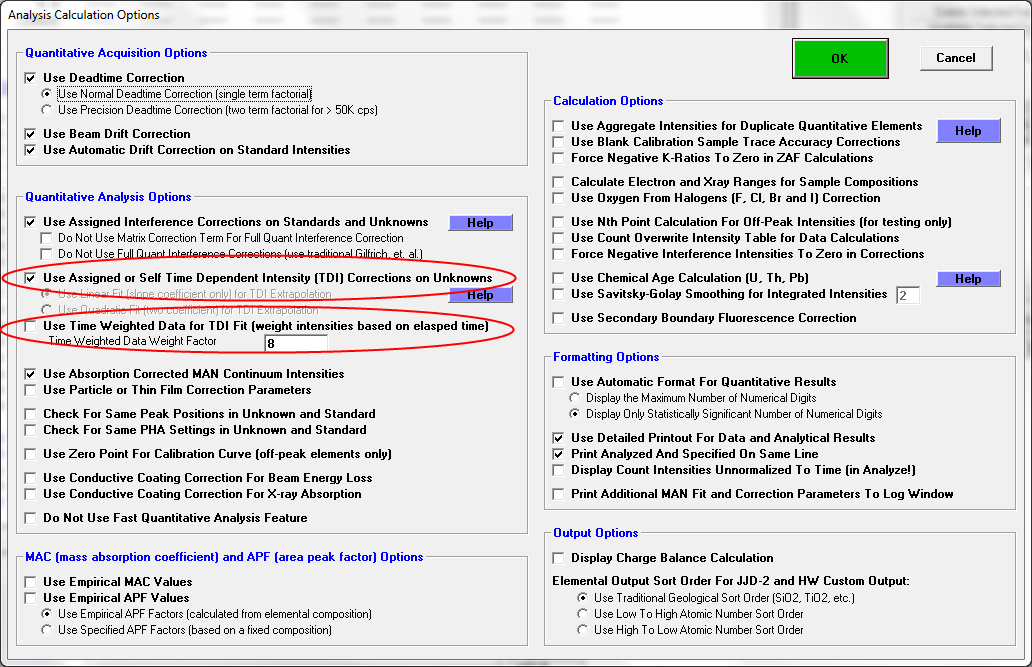
Now what does our Na data look like?
Un 6 Obsidian trav1, Results in Elemental Weight Percents
ELEM: Na Si K Al Mg Fe Ca Sr Mn S Cl Ti P Zr O H
TYPE: ANAL ANAL ANAL ANAL ANAL ANAL ANAL ANAL ANAL ANAL ANAL ANAL ANAL ANAL CALC SPEC
BGDS: MAN MAN LIN MAN MAN MAN MAN LIN LIN LIN LIN LIN EXP EXP
TIME: 90.00 60.00 20.00 80.00 60.00 160.00 80.00 40.00 30.00 100.00 100.00 100.00 100.00 100.00
BEAM: 9.99 9.99 9.99 9.99 9.99 9.99 9.99 9.99 9.99 50.29 50.29 50.29 50.29 50.29
ELEM: Na Si K Al Mg Fe Ca Sr Mn S Cl Ti P Zr O H SUM
178 3.086 35.654 3.801 7.090 .025 .497 .356 .061 .071 .002 .044 .036 .001 -.010 49.135 .000 99.848
179 3.321 35.488 3.953 6.886 .017 .483 .351 .008 .048 .003 .046 .045 -.004 -.011 48.849 .000 99.483
180 3.273 35.258 3.674 7.076 .018 .417 .364 .020 .046 .003 .042 .028 -.004 .006 48.666 .000 98.887
181 3.121 35.403 3.897 6.847 .018 .480 .362 .034 .055 -.001 .039 .050 -.003 -.009 48.652 .000 98.946
182 3.300 35.628 3.621 6.982 .022 .534 .369 -.019 .053 -.001 .041 .027 .000 -.008 49.035 .000 99.584
183 3.354 35.546 3.822 7.081 .023 .494 .371 -.001 .058 -.001 .040 .037 -.003 -.006 49.088 .000 99.904
184 3.277 35.309 3.695 6.935 .020 .471 .358 -.003 .064 .002 .035 .038 -.003 .001 48.626 .000 98.824
185 3.450 35.538 3.764 6.835 .024 .418 .365 -.008 .040 .002 .036 .020 -.001 -.020 48.838 .000 99.302
186 3.465 35.431 3.717 7.048 .026 .441 .363 -.015 .039 .001 .033 .037 .000 .000 48.925 .000 99.510
187 3.366 35.184 3.895 6.827 .024 .475 .354 .044 .033 .000 .036 .042 -.005 -.010 48.456 .000 98.721
188 3.155 35.356 3.740 6.979 .016 .392 .351 .033 .040 .001 .034 .023 .000 -.002 48.649 .000 98.768
189 3.186 35.214 3.775 7.030 .020 .372 .355 .011 .029 .001 .033 .030 .003 -.006 48.549 .000 98.601
190 3.365 35.294 3.854 7.085 .017 .473 .343 .036 .042 .002 .033 .027 -.006 -.015 48.783 .000 99.335
191 3.305 35.340 3.648 6.952 .020 .475 .351 .004 .047 -.002 .034 .039 -.002 -.020 48.664 .000 98.854
192 3.403 35.474 3.750 6.899 .019 .460 .360 .039 .063 -.001 .034 .034 -.001 -.006 48.840 .000 99.371
193 3.304 35.654 3.683 7.005 .020 .446 .366 .033 .051 .000 .034 .031 .000 -.012 49.082 .000 99.699
194 3.209 35.320 3.662 7.111 .020 .539 .351 -.009 .055 -.001 .035 .020 -.002 -.008 48.762 .000 99.064
195 3.181 35.328 3.741 7.089 .017 .476 .352 .067 .040 .000 .035 .049 .004 -.018 48.774 .000 99.136
AVER: 3.284 35.412 3.761 6.987 .020 .464 .358 .019 .049 .001 .037 .034 -.001 -.009 48.798 .000 99.213
SDEV: .110 .148 .094 .097 .003 .044 .008 .026 .011 .002 .004 .009 .003 .007 .195 .000 .403
SERR: .026 .035 .022 .023 .001 .010 .002 .006 .003 .000 .001 .002 .001 .002 .046 .000
%RSD: 3.33 .42 2.50 1.38 14.35 9.44 2.12 138.43 23.09 265.87 10.91 26.43 -199.12 -82.49 .40 .00
STDS: 336 14 374 160 162 162 162 251 25 730 285 22 285 257 0 0
STKF: .0735 .4101 .1132 .0334 .0568 .0950 .1027 .4268 .7341 .5061 .0601 .5547 .1599 .4201 .0000 .0000
STCT: 71.55 568.51 226.21 62.09 81.21 18.33 161.20 292.31 2053.05 449.51 79.86 58.15 227.12 213.15 .00 .00
UNKF: .0181 .2912 .0326 .0551 .0001 .0039 .0032 .0002 .0004 .0000 .0003 .0003 .0000 -.0001 .0000 .0000
UNCT: 17.66 403.69 65.20 102.27 .20 .75 5.02 .10 1.12 .00 .39 .03 -.01 -.03 .00 .00
UNBG: .32 .22 .94 .88 .51 .23 1.01 .94 4.78 .16 .33 .05 .81 .88 .00 .00
ZCOR: 1.8103 1.2161 1.1528 1.2688 1.4481 1.1980 1.1184 1.2337 1.2174 1.2857 1.2528 1.1970 1.4629 1.4594 .0000 .0000
KRAW: .2468 .7101 .2882 1.6472 .0025 .0407 .0312 .0004 .0005 .0000 .0049 .0005 -.0001 -.0001 .0000 .0000
PKBG: 56.05 1853.28 70.71 117.47 1.39 4.31 5.97 1.12 1.24 1.03 2.20 1.65 .98 .97 .00 .00
INT%: ---- ---- ---- ---- ---- -.02 ---- -93.84 ---- ---- ---- ---- ---- ---- ---- ----
TDI%: 78.615 -.609 -.162 -2.187 ---- .092 ---- ---- ---- ---- ---- ---- ---- ---- ---- ----
DEV%: 2.5 .7 2.5 1.2 ---- 7.6 ---- ---- ---- ---- ---- ---- ---- ---- ---- ----
TDIF: QUADRA LINEAR LINEAR LINEAR ---- LINEAR ---- ---- ---- ---- ---- ---- ---- ---- ---- ----
TDIT: 125.56 97.78 61.11 117.28 ---- 198.17 ---- ---- ---- ---- ---- ---- ---- ---- ---- ----
TDII: 18.0 404. 66.1 103. ---- .965 ---- ---- ---- ---- ---- ---- ---- ---- ---- ----
I have to say I was surprised. The time weighted data option had more effect on the data that the hyper-exponential fit (on this dataset anyway), because Na went from 3.4 wt% to 3.28 wt% *and* the overall DEV% improved to 2.5.
So, yes, Ed is correct, we should give our first TDI intervals more "weight" one way or another.